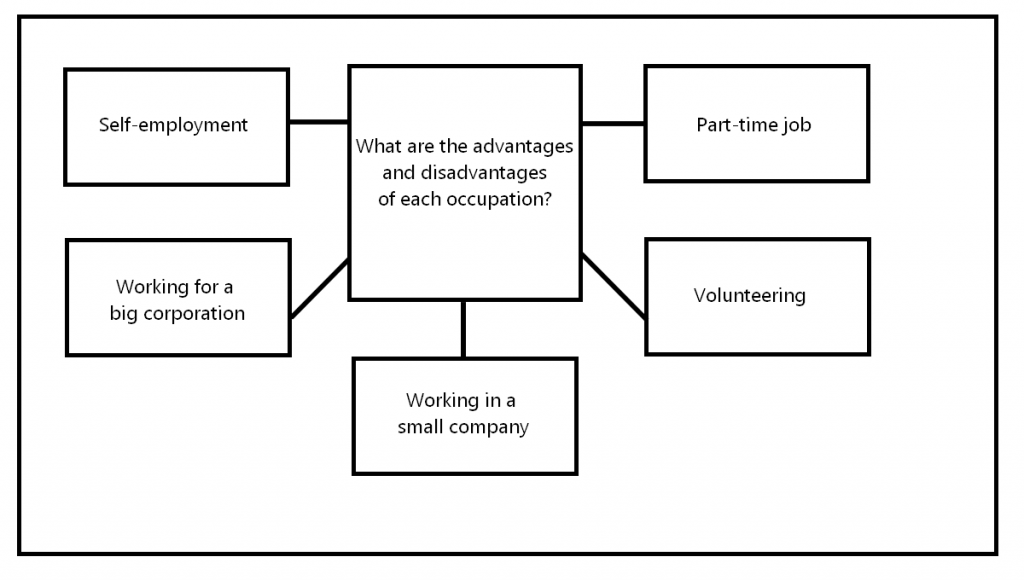CAE Speaking – EngExam.info
CAE Speaking consists of 4 parts and lasts for 15 minutes. This part normally involves two candidates, so you will have a speaking partner, a test-taker just like you. There are also going to be two people marking your answer – one asking the questions and showing the cards (the interlocutor) and the other assessing responses (the assessor). This page will guide you through the exam structure, give sample tasks with answers, provide phrases, templates and tips to make your speaking score higher! Use the menu below to help you navigate to the part you’re interested in.
1. Part 1 – Conversation between the assessor and each test-taker (2 minutes)
— 1.1 Part 1 sample questions with answers
2. Part 2 – Describing pictures. Long and short turns (3 minutes)
— 2.1 Part 2 sample pictures with answers
— 2.2 Part 2 tips and useful phrases
3. Part 3 – Discussion between candidates and reaching an agreement (discussing a mind-map) (3 minutes)
— 3.1 Part 3 sample mind-maps with answers
4. Part 4 – Discussing questions related to Part 3 topic (up to 5 minutes)
— 4.1 Part 4 sample questions with answers.
5. CAE Speaking marking criteria
Mục Lục
CAE Speaking Part 1 – Examiner and test-taker conversation
The first part consists of general questions such as “Why did you decide to take this exam?”, “How long have you been studying English?”, “What do you think is the best about your country?” and so forth. The questions then take a widened scope, the candidates are asked about their life, hobbies, plans and so on. The examiner asks both test-takers in turns. Test-takers do not get to answer the same questions. This part takes about 2 minutes.
Your responses shouldn’t be too long and will generally be as long as two or three sentences. Don’t get too carried away with the answers, you will have opportunity to give more detailed responses in next parts of the exam. However, do explain and develop your responses. Give the examiners something to assess – they are interested in your command of English. They probably don’t care much for your hobbies or food preferences.
Unlike other parts of the exam, Part 1 doesn’t really have any templates or useful phrases to learn. It’s just general English. A good thing is not to repeat yourself – you wouldn’t believe how many test-takers overuse words like very or other words that could by synonymised.
Part 1 sample questions and answers
More CAE Speaking Part 1 sample questions with answers
Where are you from?
I’m from Germany, however I was born and raised in Warsaw, Poland. My family moved to Stuttgart when I was five and I’ve been living there ever since. It is a lovely place with spectacular architecture, rich cultural heritage and generally a great place to live in.
Do you have any hobbies or interests?
I’m really into road cycling. I used to participate in amateur competitions when I was at school, I would consistently come in top three! Unfortunately, I haven’t got nearly enough time nowadays for any hobby that requires commitment. With my tight current schedule I’m lucky to have thirty minutes a day to read a book.
How long have you been learning English?
I’ve had English classes since I was seven, but I really started to apply myself in this field when I turned sixteen – I really wanted to get a degree in a prestigious university in England. Naturally, one has to have impeccable command of English to have a shot at such an ambitious plan.
What do you find most challenging about learning English?
Grammatically, it has to be articles and prepositions. My native language doesn’t really have the former, so it is a foreign concept to me, it took me a while to figure them out. As for prepositions in English, they take a lot of time to get right as they don’t really work the way they do in my language.
CAE Speaking Part 2 – Individual Long Turn
There are going to be two people – Candidate A and Candidate B – these roles are assigned randomly. Candidate A gets a set of three pictures from the examiner. The examiner then asks Candidate A to look at the pictures and answer two questions he provides. The questions can be something like “What could this people be thinking about?” and “In which situation might the people be feeling more comfortable?” with three pictures of persons in different situations. Candidate A has to choose two of the three pictures and they will have 1 minute to answer the questions.
Then the examiner reads one additional question to Candidate B using the same pictures. This time they have to choose only one picture and spend 30 seconds for the answer.
After that the candidates swap roles, Candidate B goes first with two questions and three new pictures and Candidate A gets one question and half a minute to answer it.
CAE Speaking Part 2 tips and useful phrases
Part 2 is about four things:
1 – comparing (talking about similarities and differences between the pictures)
2 – speculating (making guesses about what is going on in the pictures)
3 – describing
4 – answering the questions
1. Comparing
This aspect of Part 2 is really straightforward – we highlight similarities and differences in both photos. The only difficult part might be finding a good phrase or a template to talk about this. Here are some useful phrases for that:
Talking about similar thingsTalking about differencesBoth pictures show…
In both pictures we can see…
Both pictures one and two have…
Pictures one and two are similar in the way that there is/are… in each one.
Just like the picture on the left, the right picture has/shows…
The two pictures have a number things in common, namely…
These two pictures convey the same message/idea of… // share the same message/ideaUnlike the first picture, picture two has/shows
In contrast with the right picture, picture on the left has/shows/displays
Picture one…, while picture two…
Conversely, picture two…
Picture on the right shows a different approach to…
While the second picture takes place…, picture one…
Contrastingly, these pictures show different takes on… *some topic*
The comparison part can be extremely challenging if you choose two pictures that you can’t see any real differences in – keep that in mind when making your choice.
2. Guessing and speculating
You have to do this when answering the questions and when you describe the pictures. Showing doubt or uncertainty is one of the integral CAE Speaking Part 2 & 3 aspects.
ModalsVerbsAdverbsThis must be…
It might be…
The people may be…
It has to beSeem like/to be
Appear to be
Look likeLikely
Probably
Seemingly/supposedly
Apparently/evidently
3. Describing the pictures
When describing pictures in CAE Speaking, alternate between different phrases:
The first picture has/shows/displays
In the first picture, there is/there are/we can see
One thing to remember – don’t get spend more than 15 seconds on describing BOTH pictures. Another important aspect is not to just describe – you would want to include either comparing them or speculating:
“While in the first picture there is a man all on his own looking at a picture, the second one shows a group of kids, probably schoolchildren, enjoying a show together.”
The part in bold introduces comparison and the underlined part speculates (makes a guess) about the picture
4. Answering the question
When you address Part 2 questions, you usually do so for both pictures, either talking about differences or similarities based on the question context. You are advised to speculate as well to make your answer more hypothetical since we can’t really know it for sure. See examples below for reference.
Part 2 sample questions and answers
More CAE Speaking Part 2 sample questions with answers
CAE Speaking Part 2 Set #1
Examiner: Candidate A, here are your pictures. They show people having a nap.
I’d like you to compare two of the pictures, and say why they might have chosen to sleep like that, and how difficult it might be for them to relax.
- Why might these people have chosen to sleep like that?
- How difficult might it be for them to relax?



Sample answer
Candidate A: I’ll be comparing the top picture and the bottom right one. The group of people in the top photo seem to be sleeping at something that looks like a pier. It’s hard to guess what exactly they are doing there – they might have come here to have a quick snooze after classes. The lady in the other picture seem to be exhausted from work – she must be so tired she doesn’t even realise she is sleeping on her desk.
I’m pretty sure that neither of the situations are comfortable for sleeping – the pier’s boards are not the best surface to lie on. The person in the bottom right picture is probably feeling marginally better, seated on her chair with her head resting on her wrist.
Examiner: Candidate B, in which situation do people need to rest the most?
Candidate B: I’d have to choose the picture with the young lady sleeping next to her laptop. Obviously, it wasn’t her first choice of place to doze off – she must be absolutely knackered from all the work, otherwise she wouldn’t sleep there. She’s probably catnapping, only to continue on her project as soon as she wakes up.
CAE Speaking Part 2 Set #2
Examiner: Candidate B, here are your pictures. They show people learning new things.
I’d like you to compare two of the pictures, and say what they might find enjoyable about learning, and how effective their learning is.
- What might they find enjoyable about learning?
- How effective is their learning?



Sample answer
Candidate B: I’m going to talk about the picture with the young guy leaning on a pile of books and the child learning swimming. Both capture people in the middle of learning, however one focuses on the academic knowledge, while the other shows on a more practical skill. The guy, who seems to be a college students, doesn’t seem to be that happy – in fact, he is anything but happy, he looks pretty tired from all the rote learning. The little girl, on the contrary, is visibly elated to try the thing new to her – swimming.
I believe that the girl wearing the float suit is mastering the new skill in a much more effective way for two reasons – she’s happy to do it and she’s very young. Young kids are like sponges, taking in new information and processing it more effectively than teenagers and adults.
Examiner: Candidate A, in which picture the person is going to benefit from the new skill the most?
Candidate A: Without a doubt, it is going to be the guy with the books. One’s academic performance is directly reflected in their quality of life, so the harder he studies, the better off he’ll end up in the future, both financially and in the more general sense. He probably knows it and that is why he works himself into exhaustion to the point of dozing off on the stacked pile of books.
Remember that you should use Present Continuous when describing pictures (i.e. “This picture shows people hurrying to their work in the early morning hours”). More on tenses in English.
Another tricky bit is the preposition. You should use “in” when talking about something shown by the picture (i.e. “In this picture we see a man strolling down the alley”). See this short note on prepositions for more examples.
CAE Speaking Part 3 – Mind map discussion between two candidates
In this part, the candidates are given a mind map – a question with five prompts, or aspects, which candidates discuss together. You are given about 15 seconds to look at the question and prompts, after which your partner have to decide who starts the discussion.
Both candidates have to discuss the aspects, suggesting new ideas and developing your partner’s points. You try to maintain a discussion, asking for other participant’s opinion and giving one of your own. Neither of you should dominate the talk. This part last for about two minutes. If there are three test-takers in the group, then the time is extended to three minutes.
In the second part of this task, you have to choose one of the aspects and either agree or disagree on the discussion topic. You have one minute in this part.
Part 3 tips and useful phrases
I’d like to point out three important aspects of CAE Speaking Part 3:
1 – Starting the dialogue
2 – Connecting and transitioning the ideas
3 – Reaching an agreement
1. Starting the dialogue
At the beginning of Part 3 you have to decide who will begin the conversation. It is important to be respectful and give your partner room choice. You can either initiate this yourself of wait for your partner to go first. Here are some phrases for both:
Starting the dialogueRespondingDo you mind if I go first?
Would you mind going first/starting?
Would you care to go first?
Should I begin, or would you like to go first?
Would it be okay with you if I started this?
Is it okay for you if I start?Yeah, sure, go ahead.
Okay, I will!
I’d rather you went first, if that’s okay with you.
By all means, go ahead.
Sure, not a problem
The responses do not necessarily have to be linked to the corresponding question, so feel free to mix and match them. A good idea is to let initiator go first, but ultimately it is up to you.
2. Connecting the ideas
A common mistake in Part 3 is to simply wait for your turn to speak, without paying attention to your partner’s response. This is going to bring your mark down! Instead, you want to implement ideas from your partner’s answer into your own. It’s important to transition the ideas smoothly – your exchange should look like a dialogue, not a series of isolated sentences! Here are some ways to make your speech more cohesive:
Introducing an ideaSupporting or including an ideaWhat about…
I believe that (aspect) deserves mentioning/being mentioned
If we’re talking about (topic), then (aspect) is definitely…
I’m not sure that (aspect) is really important, however…
A point worth discussing is…Speaking of…
You’ve mentioned…, which is interesting because…
I’d like to add another point regarding…
There is one more thing about…
Another aspect of… is that…
3. Reaching an agreement
In the second half of Part 3 you have to agree upon one or two aspects of the mind-map. If you fail to agree on one, it is okay to respectfully disagree. Here are some useful phrases for suggesting, encouraging a conversation, agreeing and disagreeing:
AgreeingDisagreeing (politely)I totally agree with your point…
I’m with you on that one…
Your arguments are very compelling
I had a different idea, but your arguments sounded very convincing
Your points are very persuasive, and I side with you on that oneI see what you mean, however…
You make some valid points, but let’s consider…
With all due respect, I can’t agree/I have to disagree
Your logic here is flawless, but another point to consider is…
Suggesting ideasInviting to join… is probably one of the things we should take/consider/mention, since…
I think/believe that… is worth nominating/considering/mentioning/pointing out
Let’s not forget about…
Additionally,… should probably be included, as…Where do you stand on…?
What’s your take on…?
Please share your thoughts on this matter?
What about your idea on?
That’s what I think, but what about you?
Part 3 sample task and answers
More CAE Speaking Part 3 sample questions with answers
Here are some different types of occupation people might choose to have. First you have some time to look at the task. (15 seconds)

Now, talk to each other about the advantages and disadvantages of each of these occupations.
Sample answer
Candidate A (Boris): Do you mind if I go first?
Candidate B (Ira): Sure, go ahead.
Boris: I believe that part-time job offers a serious advantage of giving you more free time and flexibility to do something else while allowing to make enough money for a living.
Ira: It might be so, but are you sure working part-time will be enough to cover anything but one’s living expenses like bills and groceries? I really doubt it, to be honest.. I think working in a smaller company offers similar advantages to the ones you’ve mentioned, but the money must me better since you’ll be putting in more working hours.
Boris: I guess you are right. And the smaller companies are usually willing to give you more leeway with your schedule and your decisions. However, smaller businesses tend to go under quite often, so there’s very little in terms of job security. But what about self-employment? On paper, it should give you all the freedom you wish for, being your own boss and all!
Ira: Oh, I’m not so sure about that. You’ve brought up financial security, and working for yourself is such a dangerous venture! If stability is something you prioritise, that is probably not your best option. It does sound lucrative though – you earn as much as you make, there is nobody to order you around. It sounds so invigorating!
Examiner: Thank you. Now you have about a minute to decide which occupation is most stressful.
Ira: Being self-employed is likely to be the most taxing one emotionally, I mean you have the weight of decision on your shoulders, everything depends on you, all this has to really take its tall emotionally, wouldn’t you agree?
Boris: To be honest, at first I was thinking about working for a major company, but you do have a point and you’ve managed to convince me. In the light of your arguments mine seem to be irrelevant, I won’t even bother with them.
CAE Speaking Part 4 – Topic discussion
In this final part of CAE speaking you have an individual conversation with the examiner. This task is similar to the first one, but the topic of discussion is the one from Part 3. You should express and justify your opinion on the subject as the examiner guides you, asking you related questions. You might get to answer the same question as your partner. The examiner might also encourage you to engage in a dialogue with the other test-taker. This part of the exam lasts for up to 5 minutes.
Part 4 sample questions with answers
High-paying jobs
Examiner: Boris, is it better to have a high-paying job or the one that is more enjoyable?
Boris: Well, if both can’t be had, then I guess doing something you really like should be the priority. I doubt that the money you get for doing the job you loathe will do you any good. But to reiterate, ideally the two should come hand-in-hand.
Examiner: Thank you. Ira, do you agree?
Ira: Of course, you’d be really blessed to do something you’re passionate about and make good money out of it, but how often is it the case? You must be extremely lucky to find yourself in such position. If we take more realistic cases into account, then I’d go with money over enjoying what you do – in the end of the day that’s what job is all about – earning money! One can always have fun in their free time.
Unemployment
Examiner: Ira, how does unemployment affect the society in general?
Ira: It’s a tough question… Lack of job openings must have serious economic and social consequences – people are unable to afford even the most basic things, they purchasing ability goes down, which in turn affects the economy negatively. People and the society find themselves in a Catch 22 situation.
Examiner: What do you think, Boris?
Boris: I’m not sure if it is as bad as Ira makes it look. A well-qualified professional is always going to be able to find employment. It’s the lack of necessary qualifications that might be preventing certain individuals to find a position to their liking, and they are probably unwilling to resort to menial jobs. It’s all about the attitude.
Government and unemployment
Examiner: Now I would like you to discuss the following question: should government be responsible and provide for the unemployed?
Ira: I’d like to express my own opinion, if you don’t mind?
Boris: Of course, go ahead.
Ira: Thank you. I totally support this notion – the state should provide financial security for those unlucky ones without any reliable source of income. It would allow people to get better qualifications or enroll on a course to make them more employable.
Boris: You do make some valid points – it would be fair to support individuals who are keen to get re-educated to have a more relevant skill-set in the ever-changing job-market. However, I believe that this system could be easily exploited by the less conscientious individuals – people could just live off of welfare, being unemployed officially, while at the same time having a part-time job on the side. It is something that can’t be tracked easily.
Ira: It doesn’t have to be so negative, though! But I totally see what you mean, and indeed, such possibility definitely exists. I guess it’s not easy to find the middle ground in this matter.
Examiner: Thank you. That is the end of your CAE Speaking part.
CAE Speaking marking criteria
It is crucial to understand how your CAE Speaking is marked. It helps give the examiners exactly what they want and improves your chances of getting a higher score.
During the exam two independent assessing procedures take place. The assessor (the person sitting in the back taking the notes) has 5 separate marking criteria that Cambridge uses to decide how good your spoken English is:
1. Grammar
2. Vocabulary
3. Discourse Management
4. Pronunciation
5. Interactive communication
The interlocutor (the person asking the questions) assesses you using a separate criterion, referred to as “Global achievement”. All of the assessment aspects will be explained below.
Each one is scored individually from 0 to 5 in 0.5 increments. They are then combined to get the average of six.
1. Grammar
What is assessed
Naturally, the variety and accuracy of your grammar. Some examples:
– Noun, relative and adverb clauses (some examples of each)
– Active and passive forms
– Verb patterns (infinitives, to-infinitives, gerunds)
– Contrast and command of tenses (e.g. showing a temporary situation with Present Cont.)
– Modal verbs and modality
– Conditional sentences
– Ability to produce longer, multiple-clause sentences
– Flexibility (able to rephrase in order to clarify).
How to improve your score
– Alternate between active and passive voice.
– Try to introduce more advanced tenses into your narrative (e.g. Present Perfect to talk about your experience of learning English or Future Perfect to talk about plans that you are sure of).
– Learn verb patterns! They are extremely important in both written and spoken English.
– Use conditionals – Second Conditional for unlikely things in the present or in the future, Third Conditional for unreal results of things that didn’t happen. You should know all of this as CAE is a C1 level exam.
– Use a variety of modal structures – modal verbs (could, might, must) and phrases that express likelihood (probably, likely, seems to be, appears to be, looks like).
– Be ready to rephrase your phrase or sentence if you feel that they might not have sounded clear enough (usually introducing the rephrased sentence with something like “What I mean to say is…”, “In other words…”, “Allow me to clarify – I mean that…”).
When you attempt to make your speech more complex, introducing two or more clauses to your sentences, mistakes are likely to happen. If you notice that you’ve made a mistake in your speech, it is perfectly normal to try and rephrase the idea. As long as communicative task is achieved, your score won’t suffer!
2. Vocabulary
What is assessed
Just like with grammar, it is all about the range and appropriate usage of your lexical resource. Factors that influence this mark:
– Appropriate collocations
– Register (formal/informal, depending on context)
– Rephrasing (if your speaking partner does not seem to understand you (Part 3, 4)
– Using synonyms, avoiding repetition of words
What to do
– Don’t be lazy and look up collocations you aren’t sure of when you practice. A good place to start freecollocation.com dictionary. This applies to writing as well.
– Keep your register consistent throughout your response. Don’t make it too informal, be respectful to both the examiner and your fellow test-taker.
– If you see that your speaking partner struggles to understand your phrase, make sure to rephrase it.
– Be mindful about your English – listen to yourself and don’t use the same words over and over again. Here are some examples of synonyms for overused words and synonyms for “very”.
3. Discourse Management
What is assessed
In essence, this is about how well you ideas are linked – connection between words, phrases and even whole sentences. Another important thing is how easy it is to follow and understand your speech – how much sense it all makes, that is. It’s not about your pronunciation. These two aspects are usually called coherence and cohesion. Things that are assessed here:
– Cohesive devices (more on that below)
– Topical vocabulary (vocabulary related to the general theme that is being discussed)
– Various grammar that helps the listener understand what you’re referring to (articles and personal adjectives/pronouns)
– Discourse markers (words and expression that can normally only be found in spoken language, like “You know…”, “I mean… “
– Staying on topic (so-called “relevance” – you have to talk about the question, do not stray too far away from it)
– Introducing new ideas (rather than going over the thing you have already said)
How to improve your score
– Know and use cohesive devices. They can be roughly grouped into ‘adding or elaborating’ (in addition, also, moreover, as well as), ‘showing consequence or result’ (as a result, consequently, so, thus, therefore) and ‘sequencing or ordering’ (firstly, first of all, to begin with, secondly, finally). These help structure your speech, making it both connected and easier to follow.
– Expand your vocabulary. It is pretty sad to see CAE candidates struggling to come up with any relevant words on topics as simple as Food, Holidays or Career. There is no way around it, learn new words! Here is a good vocabulary link that groups words and phrases in a nice way.
– Make sure to know the basics of articles in English. Use them to your advantage. Don’t forget about possessive pronouns and adjective to make your speech more cohesive (it, this, that, one).
4. Pronunciation
What is assessed
First of all, elephant in the room – it is not about your accent. As long as your accent is easy to understand, you will do fine. This part checks other things, namely:
– Clearly pronouncing all the sounds that should be pronounced (more on that below)
– Stressing the right syllables in words (sound obvious, but it is a rather common problem)
– Using intonation to highlight and emphasise points in your speech (well-used intonation goes a long way)
How to improve your score
– Know how to pronounce words – and pronounce them with confidence. This is especially important when saying the ending of each word, as test-takers who lack confidence tend to omit the ending syllable. I would also suggest avoiding contractions, i.e. say “I have” instead of “I’ve” just to avoid ambiguity.
– Intonation is an extremely powerful tool that can drastically improve general impression of your answer. Use it to your advantage. Here is an interesting article on this topic by British Council.
5. Interactive communication
What is assessed
Your ability to sustain a conversation as well as to develop your individual response. This is what the examiners look at:
– Expanding on your answer (not giving short, uninformative responses)
– Including and encouraging your speaking partner
– Ability to initiate the exchange and to support it by contributing to the conversation or the topic
– Helping the other candidate to either phrase their ideas or suggest one for discussion
– Understanding the rhythm of a natural conversation, not “hogging” it
How to improve your score
– Short answers do not give enough information to accurately assess your level of English. To give your examiners something to work with you should come up with at least two long or three shorter sentences in Part 1 and about three to four longer sentences in Part 4.
– Be sure to include your partner! There are some phrases that you might find useful for that.
– More phrases to initiate the dialogue and to support it with your ideas
– Do not take up too much time in CAE Speaking Part 3 – remember that you only have two minutes in the first half and one minute in the second.
CAE Speaking Tips
- There is a number of typical Speaking mistakes. Know them to avoid embarrassment and guarantee a higher score.
- Do not attempt to answer other student’s question even if you see them struggling – you might get penalized for that. However, you might help them by paraphrasing your ideas in the collaborative task.
- Keep practicing. The most effective way to improve your speaking is using the language, you can do so by either having live conversations or by writing.















![Toni Kroos là ai? [ sự thật về tiểu sử đầy đủ Toni Kroos ]](https://evbn.org/wp-content/uploads/New-Project-6635-1671934592.jpg)


